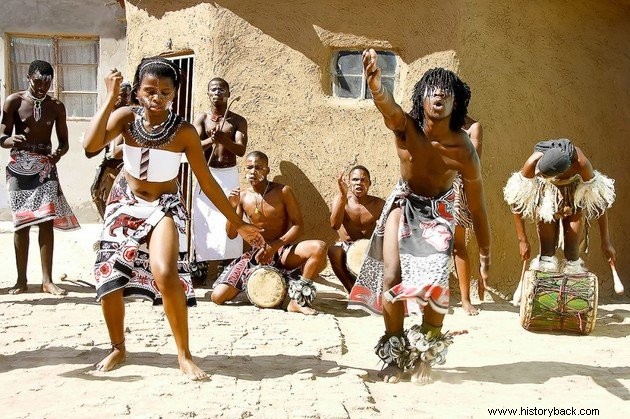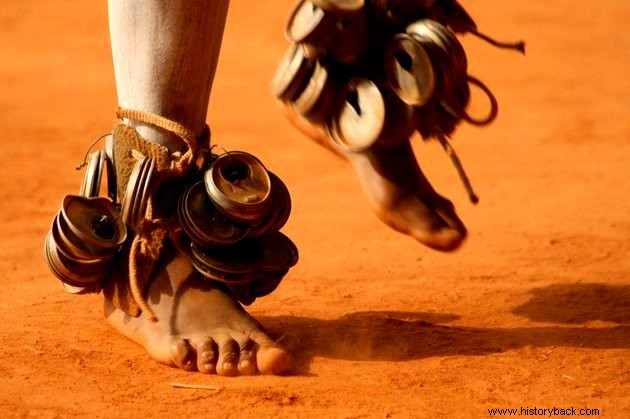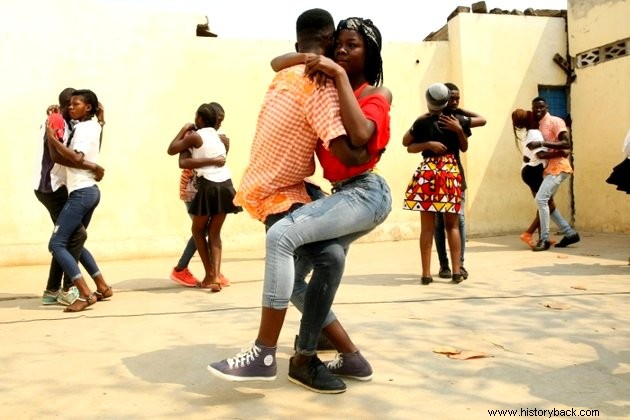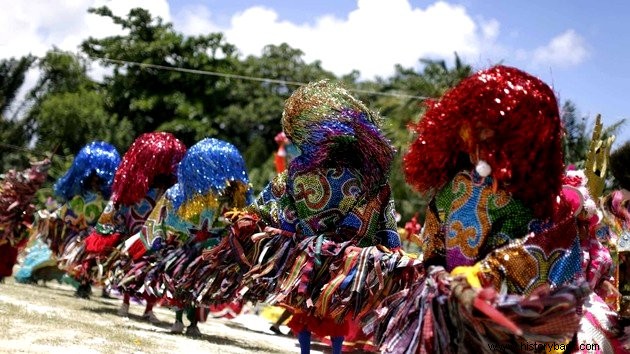The African dances they integrate the extensive culture of the African continent and represent one of the many ways of cultural communication.
This type of manifestation is of extreme importance to its people, constituting an essential part of life.
It is a way to always be connected with their ancestors and carries a powerful spiritual, emotional and artistic charge, in addition to entertainment and fun.

Characteristics of African Dances
Traditional African dances are performed on important occasions. Ceremonies in rites of passage, birth, marriage, death, harvest, war, joy, sadness, illness and thanksgiving stand out.
Although the African continent has a large area with several different countries and cultures, we can highlight common points in the dance of most African peoples:
- arranging in circles, semicircles or rows;
- the participation of all, regardless of age or social scale in the community;
- the accompaniment of music produced by the sound of percussion instruments and drum beats.
From the African dance style evolved rhythms well known by Brazilians today, such as capoeira and samba itself.
African Dance and Religion

In the view of most African peoples, dance is an important source of religious connection. In it, the body is the instrument of connection with the world of spirits.
There is a belief that, depending on the ritual, the dance should be performed barefoot to promote the connection of the spirit with the earth.
Rhythm is considered an element of passage to the spiritual world where the participant is taken after a trance.
See also:African cultureTypes of African Dances
Among the many rhythms of African origin, the following can be highlighted:the ahouach, the guedra, the schikatt, the gnawa, the kizomba and the semba.
Ahouach
Ahwach Haha Vol.1 - Melody Part 3The ahouach is danced collectively to the rhythm of Berber and represents the unity of the community.
The choreography is performed with the swaying bodies of dancers who carry heavy jewels carved in stone and amber.
The accompaniment is made by instruments such as flutes and drums made of goatskin. It is generally performed in central and southern Africa.
See also:African LegendsGuedra
GUEDRA DANCE. TARAGALTE FESTIVAL 2016The guedra is performed by the “Blue People” of the Sahara Desert. This cultural manifestation encompasses the populations of Mauritania, Morocco and Egypt.
This is a ritualistic dance in which people move in gratitude to the elements of nature:earth, air, water and fire. It is characterized by the beating of drums cradling dancers dressed in blue and white.
Schikatt
Also of Moroccan origin, the schikatt is similar to flamenco dancing. In this rhythm, the dancers reveal movements with oriental and Arab influences.
Adorned in colorful veils that cover the entire body, the dancers are also covered in jewels as they sway to the sound of clapping and percussion instruments. This is the erotic dance of the Moroccan woman.
See also:African masks:importance and meaningsGnawa
Gnawa Berber Tribe Music and DanceThe gnawa is a ritual dance that marks the passage from one world to another.
Dressed in white, the dancers simulate the presence of the god Hadra, who is brought to Earth. Under the sound of drums and clapping, acrobatic movements are performed.
Kizomba

The kizomba is a dance style originating in the 80s in Angola. Often confused with zouk , another musical and dance genre.
It is among the rhythms that most demonstrate the intercultural dynamics of African dances. It gained supporters in Brazil and, mainly, in Portugal, with several dance academies specialized in teaching the rhythm to Europeans.
This dance celebrates happiness and fellowship and has spread across the African continent. Showing smooth and rhythmic movements, it is sung in Creole and Portuguese.
See also:African Art:the cultural wealth of this great continentSemba
Fabricio Kizomba &Sabrina Improvisation SEMBAAlso of Angolan origin, semba is danced in pairs and is intended to entertain.
It is danced at parties and get-togethers, where dancers stand in pairs and perform steps marked by sensuality and juggling.
See also:Types of ArtAfro-Brazilian dances

In Brazil, the influence of African culture is enormous, due to the forced arrival of thousands of Africans who came to Brazil to be enslaved.
In this way, several musical genres and dance styles were created in the country with great African influence. Some of them are:
- Capoeira:mixes music, dance, fight and game;
- Congada:having a religious character;
- Jongo:rhythm that had a lot of influence on the creation of samba;
- Maracatu:very present in the northeast region of Brazil;
- Samba de roda:emerged in Bahia, in the 17th century, today it is part of the Intangible Heritage of Humanity .
We have more texts on the topic for you :
- What is dance?
- Main Features of Afro-Brazilian Culture
- Indigenous dances
